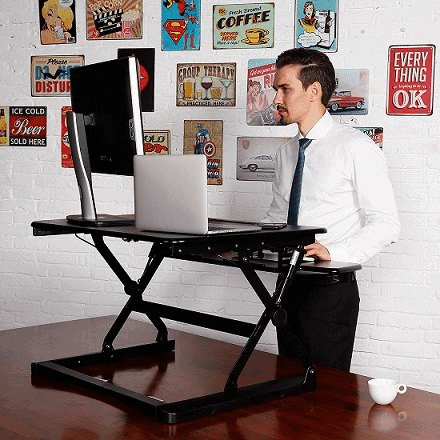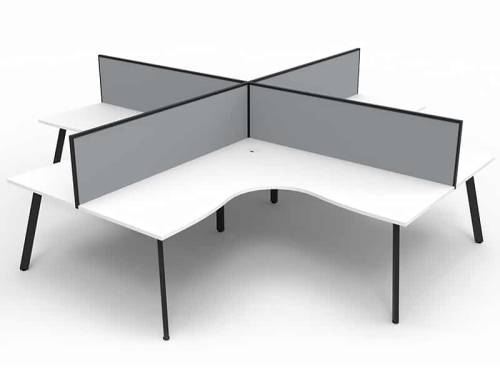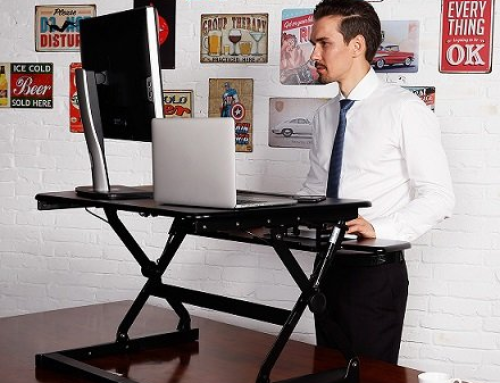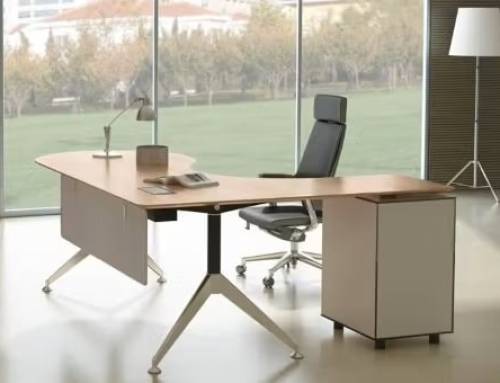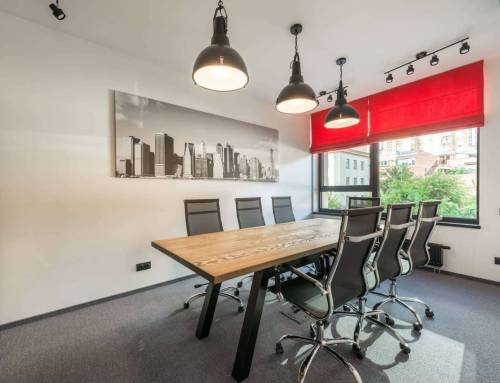Are you tired of sitting all day at work? Standing desks offer a solution to the health risks associated with prolonged sitting. This article explores the advantages of standing desks, including their health benefits and impact on productivity. We’ll guide you in choosing the right standing desk, whether you need one with drawers, storage, or a corner design. You’ll learn how to incorporate standing desks into your routine and read success stories from users. By the end, you’ll understand why standing desks are becoming essential in modern workplaces.
Key Takeaways
- Standing desks offer numerous health benefits, including improved posture, circulation, and energy levels
- Alternating between sitting and standing positions helps combat sedentary behaviour and supports weight management
- Standing desks promote mental clarity, productivity, and collaboration among employees in the workplace
- Proper ergonomics and gradual adaptation are crucial for maximizing the benefits of standing desks
- The future of office design incorporates flexible workspaces with standing desk options to support employee well-being
Recognising the Health Benefits of Standing Desks for Users
Standing desks offer numerous health benefits for users. These ergonomic workstations, such as a standing desk with drawer, enhance posture, improve circulation, and increase energy levels throughout the day. By minimising sedentary behaviour, standing corner desks support weight management and reduce the risk of cardiovascular disease. They also foster mental clarity and productivity during tasks, making them a valuable addition to any office space.
Enhance Posture to Reduce Back and Neck Strain
Standing desks promote improved posture, reducing strain on the back and neck often associated with prolonged sitting at a desktop computer. By allowing users to alternate between sitting and standing positions, these ergonomic furniture pieces, such as the standing desk with drawer, standing corner desk, and standing desk with storage, help combat the negative effects of a sedentary lifestyle on spinal alignment and muscle tension.
The vertical positioning of standing desks encourages users to maintain a more natural spine curvature, alleviating pressure on the lower back and reducing the risk of chronic pain. This improved posture also benefits the cardiovascular system, as standing promotes better blood flow to the heart and throughout the body, potentially lowering the risk of heart-related issues associated with prolonged sitting.
Improve Circulation and Reduce Risk of Cardiovascular Issues
Standing desks significantly enhance blood circulation, reducing the risk of cardiovascular issues associated with prolonged sitting. Users who alternate between sitting and standing positions throughout the day experience improved blood flow, which can boost productivity and overall health. This increased movement also helps prevent the formation of blood clots, a common concern for those who spend long hours at a computer.
The ergonomic design of standing desks, including proper cable management for computer monitors, promotes better posture and encourages more frequent movement. This active stance stimulates circulation, potentially lowering blood pressure and reducing the strain on the cardiovascular system. By incorporating standing periods into their work routine, users can mitigate the negative effects of a sedentary lifestyle on heart health while maintaining focus on their tasks.
Increase Energy Levels Throughout the Workday
Standing desks significantly boost energy levels throughout the workday. Users who alternate between sitting and standing positions experience increased alertness and reduced fatigue compared to those who remain seated in a chair. This improved energy helps maintain focus and productivity, particularly during tasks that require sustained concentration.
The act of standing engages more muscle groups, promoting better blood flow and oxygenation. This increased physical activity can contribute to weight management and may help reduce the risk of type 2 diabetes. Some standing desks, such as those made from sustainable products, offer additional health benefits by minimising exposure to harmful chemicals found in synthetic materials. The benefits of standing desks on energy levels include:
- Improved alertness and reduced fatigue
- Enhanced focus and productivity
- Better blood flow and oxygenation
- Potential weight management benefits
- Reduced risk of type 2 diabetes
Minimise Sedentary Behaviour and Its Associated Risks
Standing desks effectively minimize sedentary behaviour by encouraging users to alternate between sitting and standing throughout the day. This variation in height helps combat the negative health effects associated with prolonged sitting, such as weight gain and increased risk of cardiovascular disease. Users can easily adjust their desk height during lunch breaks or when transitioning between tasks, promoting regular movement and potentially contributing to weight loss over time.
The benefits of standing desks extend beyond health improvements, as they can also enhance workspace aesthetics. Many models feature sleek hardwood designs that complement office décor while providing ergonomic support. Although the initial price of standing desks may be higher than traditional fixed height options, the long-term health benefits and increased productivity often outweigh the cost, making them a valuable investment for both individuals and businesses.
Support Weight Management by Burning More Calories
Standing desks contribute to weight management by increasing calorie burn throughout the workday. Users who alternate between sitting and standing positions expend more energy compared to those who remain seated, potentially leading to improved weight control over time. Our brands offer adjustable options that allow customers to customise their workstations for optimal comfort and calorie expenditure.
The act of standing engages more muscle groups, particularly in the legs and core, resulting in a higher metabolic rate. This increased energy expenditure can add up over time, supporting weight management goals for office workers. Some standing desk models, feature built-in foot rests to enhance comfort and promote subtle movements that further contribute to calorie burn:
- Increased energy expenditure throughout the day
- Enhanced muscle engagement in legs and core
- Higher metabolic rate compared to sitting
- Subtle movements promoted by foot rests
- Long-term support for weight management goals
Foster Mental Clarity and Productivity During Tasks
Standing desks, promote mental clarity and productivity by improving blood flow to the brain. Users report enhanced focus and reduced mental fatigue when alternating between sitting and standing positions throughout the day. This increased alertness can lead to more efficient email management and improved task completion rates.
The ergonomic design of standing desks helps alleviate neck strain often associated with prolonged laptop use. By promoting better posture and reducing sugar cravings through increased physical activity, standing desks contribute to overall well-being and cognitive function. The benefits of using a standing desk for mental clarity and productivity include:
- Improved blood flow to the brain
- Enhanced focus and reduced mental fatigue
- More efficient email management
- Reduced neck strain from laptop use
- Decreased sugar cravings
Understanding the Impact on Workplace Productivity
Standing desks significantly impact workplace productivity by fostering active working conditions and promoting collaboration. These ergonomic workstations reduce fatigue, sustain focus, and facilitate quick transitions between sitting and standing. By optimising comfort and efficiency, standing desks enable employees to analyse productivity across various tasks. In Sydney and beyond, businesses are integrating these versatile workstations, complete with drawers and shopping cart features, to enhance their office environments.
Increase Engagement Through Active Working Conditions
Standing desks create active working conditions that increase employee engagement and productivity. Users can alternate between sitting and standing positions, reducing pressure on the body and promoting weight management. Some offices incorporate treadmill desks, allowing workers to walk at a slow pace while performing tasks, further enhancing physical activity and mental alertness.
The ergonomic design of standing desks, often featuring melamine surfaces for durability, supports proper posture and reduces physical discomfort. This improved comfort leads to increased focus and sustained productivity throughout the workday. By mitigating the negative effects of prolonged sitting, standing desks help employees maintain energy levels and engagement in their tasks.
Promote Collaboration and Interaction Among Colleagues
Standing desks promote collaboration and interaction among colleagues by creating a more dynamic office environment. The height-adjustable nature of these computer desks encourages spontaneous discussions and impromptu meetings, as employees can easily gather around a workstation without the need for a formal conference room. This fosters a sense of openness and accessibility, enhancing team communication and idea sharing.
The ergonomic design of standing desks contributes to improved office aesthetics, transforming the room into a modern, flexible workspace. By incorporating standing desks, companies can create an environment that encourages movement and social interaction. This active setting not only supports physical health but also promotes a collaborative atmosphere where employees feel more comfortable approaching one another, leading to increased productivity and innovation:
- Enhanced team communication
- Improved idea sharing
- Flexible workspace design
- Increased employee accessibility
- Promotion of an active office culture
Reduce Fatigue and Sustain Focus for Longer Periods
Research shows that standing desks help reduce fatigue and sustain focus for longer periods. Users experience improved mood and increased leg activity, leading to enhanced productivity. The ergonomic design of plywood standing desks supports proper posture, reducing physical strain and mental exhaustion throughout the workday.
Standing desk users report better customer service performance due to sustained focus and reduced fatigue. The ability to alternate between sitting and standing positions keeps employees alert and engaged, resulting in improved cognitive function and decision-making abilities. This increased alertness contributes to more efficient task completion and higher-quality work output.
Facilitate Quick Transitions Between Sitting and Standing
Standing desks facilitate quick transitions between sitting and standing positions, enhancing workplace productivity. The design of these ergonomic workstations allows users to adjust their height effortlessly, accommodating various tasks and personal preferences. This flexibility enables employees to maintain proper posture and reduce shoulder strain throughout the day.
Many standing desk brands offer electronic height adjustment mechanisms, allowing users in Melbourne and beyond to switch positions with ease. These quick transitions help maintain focus and energy levels, contributing to increased productivity. The ability to alternate between sitting and standing also promotes better circulation and reduces the risk of fatigue associated with prolonged static postures:
Optimise Workspaces for Comfort and Efficiency
Standing desks optimize workspaces for comfort and efficiency by promoting proper posture and reducing pain. In Australia, these ergonomic solutions have gained popularity for their ability to alleviate back and neck discomfort associated with prolonged sitting. Many models feature powder coating finishes, ensuring durability and easy maintenance in office environments.
The adjustable nature of standing desks allows users to customize their work setup, improving efficiency and productivity. Some advanced models incorporate electricity-powered height adjustment mechanisms, enabling seamless transitions between sitting and standing positions. This flexibility supports pain management strategies, allowing employees to find their optimal working posture throughout the day:
Analyse Productivity in Different Tasks With Standing Desks
Standing desks enable users to analyse productivity across various tasks by providing ergonomic flexibility. The adjustable height feature allows workers to find optimal positions for different activities, such as using a keyboard tray for typing or raising the desk for collaborative discussions. This adaptability supports improved elbow positioning, reducing strain during extended work periods.
Environmentally friendly standing desk models often incorporate a cart system for easy mobility, allowing users to reconfigure their workspace as needed. Some designs feature a one-touch button for effortless height adjustments, enabling quick transitions between tasks. By facilitating these seamless changes, standing desks help employees maintain focus and energy levels throughout diverse work activities.
Selecting the Ideal Standing Desk for Your Needs
Selecting the ideal standing desk involves evaluating height adjustability, choosing between manual and electric options, and considering desk size. Users should research ergonomic accessories to complement their setup, including wrist supports. Reading reviews helps identify reliable models, while visiting showrooms allows for hands-on testing. These factors contribute to creating a healthier workspace that may positively impact blood pressure and overall well-being.
Evaluate Height Adjustability and Functionality
When evaluating standing desk options, users should prioritize height adjustability and functionality to ensure optimal usability. The range of adjustment should accommodate various user heights and allow for seamless transitions between sitting and standing positions. This versatility enhances the desk’s value as a long-term investment, potentially reducing inflammation associated with prolonged sitting.
Functionality extends beyond height adjustment to include features such as stability, weight capacity, and compatibility with existing office chairs. Users should consider the available space in their work environment and choose a desk that fits comfortably while providing ample surface area for tasks. Some models offer additional ergonomic features, such as keyboard trays or monitor arms, which can further improve overall workspace efficiency.
Choose Between Manual and Electric Options
When selecting a standing desk, users must choose between manual and electric options. Manual desks offer a cost-effective solution for those who prefer mechanical height adjustment. These models suit warehouse environments where electrical connections may be limited, and they provide a reliable option for users concerned about potential electronic malfunctions.
Electric standing desks, on the other hand, offer effortless height adjustments with the push of a button. This feature benefits individuals with chronic kidney disease or other conditions that may limit mobility. Many electric models incorporate Bluetooth connectivity, allowing users to pre-set preferred heights for optimal typing ergonomics. The ease of adjustment encourages more frequent position changes, potentially reducing the health risks associated with prolonged sitting.
Consider Desk Size to Fit Your Workspace
When selecting a standing desk, users must consider the size that best fits their workspace. Most popular models offer various dimensions to accommodate different room layouts. Users should measure their available space and consider the desk’s footprint, ensuring it allows for comfortable movement and accommodates necessary equipment.
For those with limited space, compact options or a laptop stand for a desk can provide ergonomic benefits without overwhelming the room. The Lift Desk series offers adjustable widths, allowing users to customize their workspace to fit perfectly. When choosing a desk size, consider the following factors:
Research Ergonomic Accessories to Complement Your Setup
When selecting a standing desk, users should research ergonomic accessories to complement their setup. Our adjustable height desks often come with pre-drilled holes for easy accessory integration. Popular additions include monitor arms, keyboard trays, and anti-fatigue mats, which enhance comfort and productivity for stand up desk users.
Sit stand desk enthusiasts can benefit from cable management systems to keep their workspace organised. Adjustable desk owners may consider investing in ergonomic chairs for periods of sitting, ensuring a seamless transition between postures. Some accessories to consider include:
- Monitor arms for optimal screen positioning
- Keyboard trays to maintain proper wrist alignment
- Anti-fatigue mats for comfort during standing periods
- Cable management systems for a tidy workspace
- Ergonomic chairs for sitting breaks
Read Reviews to Find the Most Reliable Models
Reading reviews helps users identify the most reliable standing desk models, such as height adjustable desks and electric desks. Customers can gain insights into the durability, stability, and overall performance of various brands by examining feedback from long-term users. This research process allows potential buyers to compare features like weight capacity, adjustment speed, and noise levels across different rising desk options.
Professional reviewers often provide in-depth analyses of standing tables and the best sit stand desks, highlighting both strengths and weaknesses. These expert opinions can guide users toward models that offer the best value for their specific needs, taking into account factors such as warranty coverage, customer service quality, and ease of assembly. By thoroughly examining reviews, customers can make informed decisions and select a reliable standing desk that will enhance their ergonomic workspace for years to come.
Visit Showrooms to Test Desks Before Purchasing
Visiting showrooms allows potential buyers to test adjustable office desks before making a purchase. Users can experience the smooth operation of electric sit stand desks first hand, assessing factors such as stability, noise levels, and height adjustment speed. This hands-on approach helps individuals determine which features are most important for their specific needs and work style.
Showroom visits provide an opportunity to compare different models side by side, enabling users to evaluate the build quality and aesthetics of various standing desk options. By testing desks in person, customers can make informed decisions about ergonomic fit, ensuring they select a model that promotes proper posture and comfort throughout the workday.
Incorporating Standing Desks Into Your Routine
Incorporating standing desks into a daily routine requires thoughtful planning and gradual adjustments. Users should increase standing time progressively, alternate between sitting and standing, and optimize screen height to prevent eye strain. Utilizing under-desk mats, setting position change reminders, and creating an efficient workspace layout can enhance comfort and productivity while using a standing desk.
Gradually Increase Standing Time to Acclimate Your Body
Users should gradually increase their standing time when incorporating a standing desk into their routine. Starting with short periods of 15-30 minutes, individuals can slowly build up their endurance over several weeks. This approach allows the body to adapt to the new posture and minimizes potential discomfort associated with prolonged standing.
A structured approach to increasing standing time helps users acclimate effectively. By setting achievable goals and tracking progress, individuals can optimize their standing desk experience. The following table outlines a sample schedule for gradually increasing standing time:
Alternate Between Sitting and Standing to Maintain Comfort
Users of standing desks benefit from alternating between sitting and standing positions throughout the workday. This variation helps maintain comfort and reduces the risk of fatigue associated with prolonged static postures. By changing positions regularly, individuals can optimize their ergonomic setup and sustain productivity levels.
A recommended approach is to alternate between sitting and standing every 30 to 60 minutes. This frequency allows users to reap the benefits of both positions while preventing discomfort. The following table outlines a sample schedule for alternating between sitting and standing:
Adjust Screen Height to Prevent Eye Strain
Proper screen height adjustment is crucial when using a standing desk to prevent eye strain and maintain good posture. Users should position their monitors at eye level, with the top of the screen aligned with or slightly below their horizontal line of sight. This setup reduces neck strain and allows for a comfortable viewing angle, minimizing the risk of visual fatigue during prolonged work sessions.
To achieve optimal screen height, users can utilize monitor arms or adjustable stands that complement their standing desk setup. These accessories enable fine-tuning of screen position based on individual height and preferences. Regular adjustments throughout the day, as users alternate between sitting and standing positions, ensure consistent ergonomic benefits and help maintain productivity while reducing the risk of eye strain and associated discomfort.
Utilise Under-Desk Mats for Added Comfort
Users of standing desks can enhance their comfort by utilising under-desk mats. These ergonomic accessories provide cushioning support for the feet and legs, reducing fatigue and promoting better circulation during extended periods of standing. Anti-fatigue mats with textured surfaces encourage subtle foot movements, further improving blood flow and reducing the risk of discomfort.
When selecting an under-desk mat, users should consider factors such as material durability, thickness, and size to ensure compatibility with their standing desk setup. Some advanced mats feature contoured designs or built-in foot rollers, offering additional options for movement and comfort throughout the workday. Regular use of these mats can contribute to a more comfortable and sustainable standing desk experience.
Set Reminders to Change Positions Throughout the Day
Users of standing desks benefit from setting reminders to change positions throughout the day. These prompts help maintain a healthy balance between sitting and standing, reducing the risk of fatigue and discomfort associated with prolonged static postures. By implementing regular position changes, individuals can optimise their ergonomic setup and sustain productivity levels.
Various methods can be employed to set effective reminders for position changes. Users may utilise smartphone apps, desktop notifications, or wearable devices to prompt regular transitions. A sample schedule for position changes throughout the workday might include:
Create a Standing-Friendly Workspace Layout for Efficiency
Creating a standing-friendly workspace layout enhances efficiency and comfort for users of standing desks. The arrangement should prioritise easy access to frequently used items and minimize unnecessary reaching or bending. Users can organise their workspace by placing essential tools and equipment within arm’s reach, reducing strain and promoting a seamless workflow.
Proper cable management is crucial for a clean and functional standing desk setup. Users should utilise cable trays or clips to keep wires organised and prevent tripping hazards. Additionally, incorporating adjustable monitor arms allows for optimal screen positioning as users transition between sitting and standing positions. The following table outlines key elements of an efficient standing-friendly workspace layout:
Sharing Success Stories of Standing Desk Users
This section highlights the real-world impact of standing desks through user experiences. It presents employee testimonials, productivity case studies, and workspace comparisons. The content explores team dynamics improvements, health achievements, and insights from workplace wellness programs, offering a comprehensive view of standing desk benefits in professional settings.
Gather Testimonials From Employees Who Shifted to Standing Desks
Gathering testimonials from employees who transitioned to standing desks provides valuable insights into the real-world benefits of these ergonomic workstations. Companies can collect feedback through surveys, interviews, or focus groups, capturing diverse experiences across different departments and job roles. These testimonials often highlight improvements in energy levels, productivity, and overall well-being.
Employee testimonials serve as powerful tools for encouraging wider adoption of standing desks within organizations. By sharing success stories, companies can address common concerns and demonstrate the practical advantages of incorporating these workstations into office environments. These first hand accounts help potential users understand how standing desks can positively impact their daily work routines and long-term health.
Highlight Case Studies Showcasing Productivity Increases
Case studies showcasing productivity increases with standing desks provide compelling evidence for their effectiveness in the workplace. These studies often track key performance indicators such as task completion rates, error reduction, and overall output quality before and after the implementation of standing desks. By quantifying the impact on productivity, organizations can justify the investment in ergonomic workstations and encourage wider adoption among employees.
One notable case study conducted at a software development firm revealed a 15% increase in code output and a 20% reduction in debugging time after transitioning to standing desks. The study attributed these improvements to enhanced focus, reduced physical discomfort, and increased energy levels among developers. Such tangible results demonstrate the potential of standing desks to positively impact both individual and team performance across various industries.
Showcase Before-and-After Comparisons of Workspace Setups
Before-and-after comparisons of workspace setups effectively illustrate the transformative impact of standing desks on office environments. These visual representations showcase the ergonomic improvements achieved through the integration of adjustable-height workstations, highlighting the shift from sedentary arrangements to more dynamic and health-conscious spaces. Companies often document these changes through high-quality photographs or videos, capturing the evolution of individual workspaces and entire office layouts.
These comparisons serve as powerful tools for demonstrating the practical benefits of standing desks to potential adopters. By juxtaposing traditional seated setups with their standing counterparts, organizations can visually communicate the enhanced ergonomics, improved space utilization, and overall modernization of the work environment. These before-and-after showcases often feature employee testimonials, providing context and personal insights into the positive changes experienced following the transition to standing desks.
Illustrate Team Dynamics Improvement With Standing Options
Standing desk options have significantly improved team dynamics in many workplaces. Organizations report increased collaboration and spontaneous interactions among employees, as the height-adjustable desks encourage movement and facilitate impromptu discussions. This enhanced mobility has led to more frequent knowledge sharing and creative problem-solving sessions, ultimately boosting overall team productivity.
The introduction of standing desks has also fostered a more inclusive work environment. Employees with different physical needs or preferences can now participate comfortably in group discussions and meetings, regardless of whether they choose to sit or stand. This flexibility has contributed to improved communication and a stronger sense of team unity, as staff members feel more engaged and valued in their workspace.
Celebrate Health and Wellness Achievements of Users
Standing desk users have reported significant health and wellness achievements, including improved posture, reduced back pain, and increased energy levels throughout the workday. Many employees have experienced weight loss and better blood sugar control as a result of the increased physical activity associated with standing desks. These positive outcomes have contributed to higher job satisfaction and overall well-being among users.
Organizations have celebrated these health milestones through wellness programs and recognition initiatives. Some companies have implemented challenges and rewards systems to encourage consistent use of standing desks, leading to long-term lifestyle changes. By acknowledging and sharing these success stories, businesses have fostered a culture of health-consciousness and ergonomic awareness in the workplace.
Share Insights From Workplace Wellness Programs
Workplace wellness programs incorporating standing desks have yielded valuable insights into employee health and productivity. Organisations report increased participation in wellness initiatives when standing desks are introduced, as employees become more aware of their physical well-being throughout the workday. These programs often track metrics such as daily standing time, step counts, and overall activity levels, providing data-driven evidence of the positive impact on employee health.
Successful workplace wellness programs have found that combining standing desk implementation with ergonomic training and regular health assessments leads to more sustainable behavioural changes. Companies have observed reductions in absenteeism and health-related costs, attributing these improvements to the holistic approach of integrating standing desks into broader wellness strategies. These insights have prompted many organizations to expand their wellness programs, recognizing the long-term benefits of investing in employee health and ergonomic workspaces.
Learning About Future Trends in Ergonomics
The future of ergonomics in office environments focuses on innovative standing desk technology, evolving ergonomic furniture, and workstation wellness research. As remote work influences desk design, workplace culture and layouts are shifting. Standing desks play a crucial role in modern offices, adapting to these trends and promoting healthier work environments.
Investigate Innovations in Standing Desk Technology
Recent innovations in standing desk technology focus on enhancing user experience and health benefits. Smart standing desks now incorporate AI-driven algorithms that learn user preferences and automatically adjust height throughout the day, promoting optimal posture and movement patterns. These advanced systems often integrate with wellness apps, providing personalized recommendations for sitting and standing intervals based on individual health data.
Ergonomic advancements have led to the development of dynamic standing desks that encourage subtle movements while working. These desks feature slightly unstable platforms that engage core muscles and promote better balance, further increasing the health benefits of standing while working. Some models also incorporate built-in treadmills or cycling mechanisms, allowing users to engage in light exercise during the workday without disrupting their productivity.
Explore Developments in Ergonomic Office Furniture
Recent developments in ergonomic office furniture have expanded beyond standing desks to encompass a wide range of innovative products. Adjustable monitor arms, ergonomic keyboards, and active sitting chairs now complement standing desks, creating comprehensive workstations that prioritize user comfort and health. These advancements aim to reduce repetitive strain injuries and promote better posture throughout the workday.
Manufacturers are incorporating sustainable materials and modular designs into ergonomic furniture, allowing for easy customization and upgrades. This approach not only extends the lifespan of office furniture but also enables businesses to adapt their workspaces to evolving employee needs and technological advancements. The integration of smart sensors and IoT connectivity in ergonomic furniture provides valuable data on usage patterns, helping organizations optimize their workplace layouts and improve employee well-being.
Keep Up With Research on Workstation Wellness
Recent research on workstation wellness has revealed the importance of dynamic movement throughout the workday. Studies show that alternating between sitting and standing positions can significantly reduce the risk of musculoskeletal disorders and improve cognitive function. Researchers are now exploring the potential benefits of integrating mild physical activity into office routines, such as desk-based exercises or active sitting solutions.
Ongoing studies are investigating the long-term effects of standing desk usage on employee health and productivity. Preliminary findings suggest that consistent use of standing desks may contribute to improved cardiovascular health and reduced absenteeism. Researchers are also examining the psychological benefits of ergonomic workstations, including their potential impact on job satisfaction and stress reduction in office environments.
Review Potential Impacts of Remote Work on Desk Design
The rise of remote work has significantly influenced standing desk design, prompting manufacturers to develop more versatile and compact models. These new designs often feature collapsible frames and lightweight materials, allowing users to easily set up and store their workstations in home environments with limited space. Additionally, manufacturers are incorporating built-in cable management systems and integrated power solutions to accommodate the diverse tech setups required for remote work.
Remote work has also accelerated the development of smart standing desks that can be controlled and monitored remotely. These advanced workstations often include features such as smartphone integration, allowing users to adjust desk height, track usage patterns, and receive ergonomic reminders throughout the day. The following table illustrates key design changes in standing desks driven by the remote work trend:
Anticipate Shifts in Workplace Culture and Layout
The future workplace culture and layout are expected to shift towards more flexible and health-conscious designs. As organizations recognize the benefits of standing desks and ergonomic workstations, open floor plans are being reimagined to accommodate a mix of sitting and standing areas. This evolution promotes movement and collaboration while catering to diverse working preferences.
Companies are increasingly adopting activity-based working models, where employees have access to various workspaces designed for specific tasks. This approach often includes standing desk zones, quiet focus areas, and collaborative spaces, allowing staff to choose the most appropriate setting for their current work. The shift towards more dynamic office layouts reflects a growing emphasis on employee well-being and productivity:
- Flexible work zones with standing desk options
- Quiet focus areas for concentrated tasks
- Collaborative spaces encouraging movement and interaction
- Ergonomic furniture throughout the office
- Adjustable workstations to accommodate different preferences
Discuss the Role of Standing Desks in Modern Office Environments
Standing desks have become integral components of modern office environments, promoting employee health and productivity. These ergonomic workstations offer users the flexibility to alternate between sitting and standing positions throughout the day, reducing the risks associated with prolonged sedentary behaviour. As organizations prioritize employee well-being, standing desks have evolved from novelty items to essential office furniture, supporting a more dynamic and health-conscious work culture.
The role of standing desks extends beyond individual health benefits, influencing office design and workplace dynamics. Many companies now incorporate standing desk zones into their floor plans, creating diverse work areas that cater to different tasks and preferences. This shift has led to more collaborative and adaptable office spaces, where employees can easily transition between seated and standing work, fostering increased movement and informal interactions throughout the workday.
Frequently Asked Questions
What are the main health benefits of using a standing desk?
Standing desks offer several health benefits, including improved posture, reduced back pain, increased energy levels, and better blood circulation. They can also help burn more calories, lower the risk of obesity and cardiovascular disease, and enhance productivity by keeping users more alert and focused throughout the workday.
How do standing desks affect workplace productivity?
Standing desks can boost workplace productivity by reducing sedentary behaviour, improving posture, and increasing energy levels. Studies suggest they may enhance focus, reduce back pain, and promote better blood circulation, leading to improved cognitive function and overall employee well-being throughout the workday.
What factors should I consider when choosing a standing desk?
When choosing a standing desk, consider ergonomics, height adjustability, desk size, weight capacity, material quality, stability, ease of adjustment, and available workspace. Also, factor in your budget, office layout, and any additional features like built-in cable management or programmable height settings.
How can I incorporate a standing desk into my daily work routine?
To incorporate a standing desk into your daily routine, start with short standing periods and gradually increase duration. Alternate between sitting and standing throughout the day, aiming for a 1:1 ratio. Use an anti-fatigue mat and comfortable shoes for support.
What are the future trends in ergonomic office furniture?
Future trends in ergonomic office furniture include adjustable sit-stand desks, active seating options, biophilic design elements, smart furniture with integrated technology, and customizable workstations. These innovations aim to enhance comfort, productivity, and well-being in the modern workplace.
Standing desks offer significant health and productivity benefits, including improved posture, increased energy levels, and enhanced mental clarity. By incorporating these ergonomic workstations into office environments, organizations can foster a more dynamic and health-conscious workplace culture. The versatility of standing desks, coupled with ongoing innovations in ergonomic furniture design, positions them as essential components of modern offices. As workplace wellness continues to gain importance, standing desks will play a crucial role in supporting employee well-being and driving organizational success.

